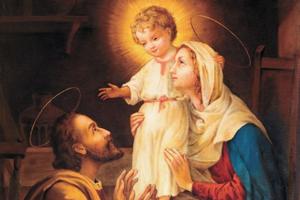Sts. Joseph and Patrick Are March’s Mercy Men
Lessons From the Patrons of the Jubilee

Two young men were coming toward him. One was pushing the other in a wheelchair. As they drew closer, he saw the one in a wheelchair was a quadriplegic on a ventilator. The man pushing the chair was blind. The quadriplegic had a pair of eyes that worked well; the blind man had legs and arms that worked well.
It was mercy in action.
“That changed my life,” recalled Rick Sarkisian, who decided to become a rehabilitation counselor after that encounter. “We should consider creating that partnership with St. Joseph, the man closest to Christ,” whom the Church celebrates on March 19.
Sarkisian, a Californian who specializes in working with traumatically injured people facing complete employment loss and career change, sees Joseph as a “merciful patron.”
He added, “St. Joseph is the premiere example for us because nothing was more important to him than to find, follow and fulfill God’s will for his life.”
Sarkisian, who has written several books on St. Joseph, suggests that by following Joseph’s example of mercy, “we will experience much in return.”
Leon Joseph Suprenant’s patron saint is, of course, St. Joseph.
“He was also certainly a father in a true sense to the Child Jesus, and what parent isn’t required to do all the works of mercy?” said Suprenant, pastoral associate for administration in the permanent diaconate in the Archdiocese of Kansas City, Kan.
“We try, like Mother Teresa, to see Jesus in the people we serve. For St. Joseph, that was Jesus,” Suprenant said.
Pope Francis spoke of this same quality on St. Joseph’s feast day in 2014, “St. Joseph is the model educator and father, the model for dads.”
Certainly, along with Mary as the model mother and Mother of Mercy, St. Joseph is the model father and father of mercy.
Present Moment Mercy
Mike Wick, executive director of the Institute on Religious Life, believes St. Joseph is also the patron of right now.
“The beauty of Joseph is that he lived totally in the present moment,” said Wick.
No matter the situation, Suprenant admires the quick response on the part of St. Joseph. “‘Okay, we will be married.’ ‘Okay, let’s go to Egypt.’ ‘Okay, let’s go find Jesus.’ ‘I realize you’re the Son of God, but I’ll show you what I know.’ He was docile and willing to put himself at the service of Divine Mercy, in that regard.”
Suprenant connects Joseph’s response to another aspect of mercy, too.
“Being unmerciful means insisting on your path,” he explained. But St. Joseph did the opposite.
“He was always docile to what the Lord wanted him to do, and that really is a key component to mercy,” explained Suprenant. “In other words, for us to be merciful to others means we have to be willing to change, and Joseph was willing to change and to receive instructions in a dream and do things that he otherwise might consider unthinkable.”
Another Mercy Saint
St. Patrick, whose feast day is March 17, also exhibited mercy in a way some would consider unthinkable. He returned as a missionary to convert the pagans who had kidnapped and enslaved him for six years in Ireland before he escaped. But he went back to bring the Good News that eventually converted the Emerald Isle to Catholicism.
Wick admires Patrick for “instructing the ignorant, counseling the doubtful, giving drink to those thirsty for truth and probably feeding the hungry in corporal and spiritual ways.”
John Preiss, president of the Fatima Family Apostolate (FatimaFamily.org) and head of the Apostolate of St. Joseph (ApostolateStJoseph.com), finds “St. Joseph and St. Patrick are pretty well tied together. Both were humble and gentle, and they trusted God in every move that they made. What they did was not something they thought out — they were doing what God wanted them to do. For the conversations, St. Patrick put it in God’s hands, and with St. Joseph, everything was in God’s hands.”
While Patrick carried on evangelization publicly as a bishop and missionary, St. Joseph gave a quiet example of evangelization, said Preiss. “He did everything a father should do. He made all the right decisions. He was always there for Jesus and Mary and supported them,” putting mercy in action in family life.
St. Joseph’s taking on being the foster father to the Son of God was “definitely an act of mercy.” Therefore, adoptive parents can follow the holy footsteps of St. Joseph.
Suprenant and his wife, Maureen, have six children. Three are adopted, of whom the two youngest are boys.
“Mary gave her fiat, and so did Joseph,” he explained.
Added Suprenant, “That gives me inspiration for my boys. I’ve made a choice and commitment before God to treat them in all respects as they were my own flesh and blood. And in a sense, I truly believe they are. Adoption is a beautiful act of mercy — one of many forms of healing and making right circumstances that weren’t right.”
Indeed, in adoption court, he said, everyone is usually happy, and the judge is smiling.
“You want to see mercy, a true goodness in establishing family ties that weren’t there before,” Suprenant said. “Isn’t that what God’s mercy is — establishing family ties [with us] being children of God?”
And Joseph’s love of Mary is also key. “That’s something St. Joseph did and something I see as some important aspect of the Joseph in me — making sure the children love and respect their mother,” Suprenant said.
For Wick, these saints’ example of mercy can be tied into the New Evangelization, “which, in this Year of Mercy, is an opportunity to stress this whole concept of evangelization through mercy.”
Joseph Pronechen is a
Register staff writer.
Shutterstock image
- Keywords:
- st. joseph
- st. patrick
- works of mercy
- year of vocations

















